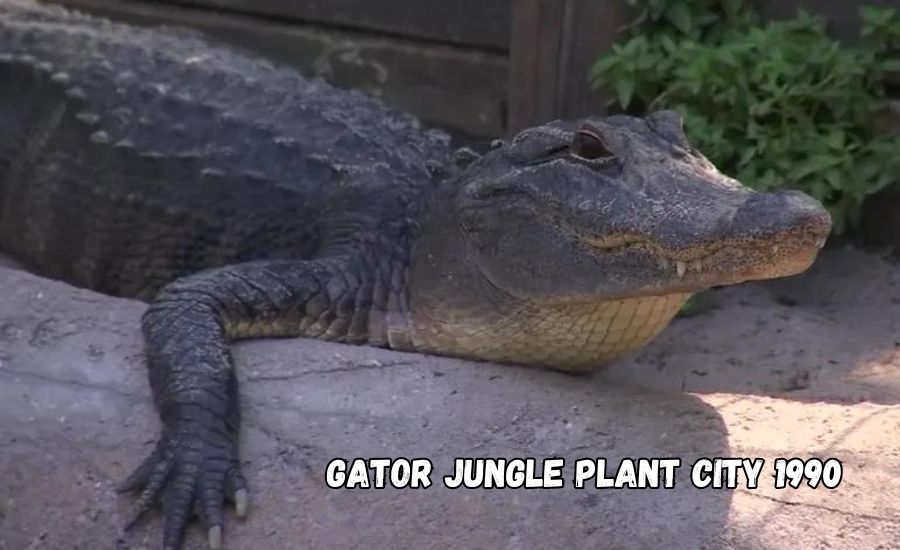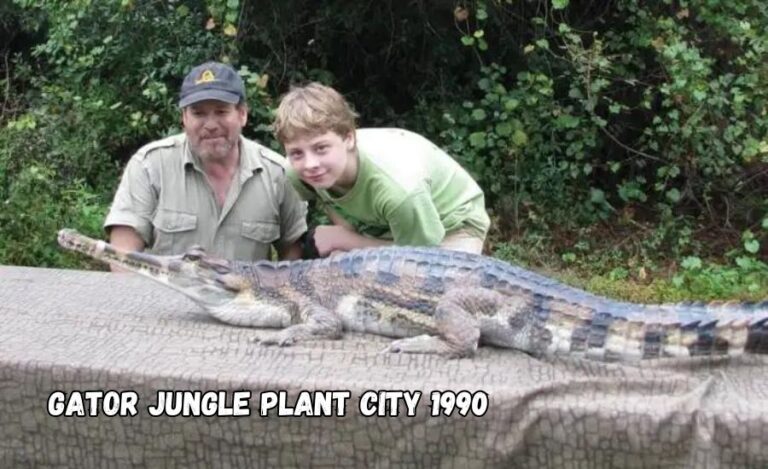In 1990, an unexpected event put Plant City, Florida, on the map in a unique way. Known for its strawberries and small-town charm, Plant City wasn’t a place where you’d expect to see headlines about wild animals. Yet, Gator Jungle, a lesser-known but beloved local attraction, became a talking point for many Floridians that year. The park, filled with alligators, crocodiles, and other exotic animals, experienced a mix of wildlife encounters, accidents, and controversies that shaped its reputation.
This article dives deep into what happened at Gator Jungle in Plant City in 1990, highlighting the key incidents, accidents, and the larger implications for wildlife safety. We’ll explore the history of Gator Jungle, how it became a favorite for tourists and locals alike, and how it eventually closed its doors. Let’s begin by looking at the wild story that made this park so unforgettable.
A Brief History of Gator Jungle in Plant City
Gator Jungle was located on Interstate 4, just outside Plant City, Florida. While not as famous as other attractions like Busch Gardens or Disney World, it had a rustic, down-home charm that appealed to tourists looking for something different. The park, owned by the Howell family, was known for its collection of over 600 alligators, along with other wildlife like bobcats, emus, and even a wrestling bear named Toby.
The park’s main attraction, however, was the alligators. From baby gators to massive 60-year-old reptiles like King, who was notorious for being mean and missing a claw, Gator Jungle offered a rare, up-close experience with these creatures. Visitors could even hold small alligators like Charlie, a 2-foot-long young gator who was often described as “sweet as a kitten.”
The 1990 Incident: What Happened at Gator Jungle?

In the spring of 1990, an incident occurred that shook the local community and raised questions about safety at wildlife parks. A large 8-foot alligator made its way into a residential area near Gator Jungle, causing panic among local residents. This event was alarming but not entirely surprising to those familiar with Florida’s wildlife patterns.
During the alligator’s wanderings, it found its way onto the property of Karen Neumann, a local resident. The situation quickly escalated when a neighbor knocked on her door to warn her about the gator lurking near her RV. Alarmed, Neumann immediately ensured the safety of her grandkids and pets, while a professional trapper was called to handle the situation.
The trapper successfully captured the alligator without harm to anyone, but the incident left the community in shock. It highlighted the very real dangers of living close to a place like Gator Jungle, where large and potentially dangerous animals were a part of everyday life.
Gator Jungle Plant City 1990: Accidents and Controversies
While the 1990 alligator incident drew attention to the park, it wasn’t the only controversy that year. Gator Jungle, like many wildlife parks, faced challenges related to animal handling, safety, and even legal issues. One of the most significant concerns at the time was the risk posed to visitors, especially children, who interacted with the animals.
In one of the more troubling accidents in 1990, a child was reportedly nipped by an alligator while attempting to pet it. Although the alligator, which was likely wearing a muzzle, did not cause serious injury, the incident sparked debates about whether Gator Jungle was properly safeguarding its visitors. The park’s staff, including handler Chuck Wright, regularly reassured guests that precautions were in place, but accidents like these left parents feeling uneasy.
There were also rumors of arrests related to animal mistreatment, though these claims were never fully substantiated. However, the controversy surrounding the park led to increased scrutiny from local authorities and animal rights groups. The question on everyone’s mind was whether a place like Gator Jungle could balance the thrill of up-close animal encounters with the need for safety.
The Wildlife Experience: Encounters at Gator Jungle
Despite the controversies, Gator Jungle was a place where people could experience Florida’s wildlife in a way that few other places offered. Visitors from all over the world, especially tourists from Canada, made their way to Plant City to see the park’s famous alligators. One of the most popular experiences was the chance to hold a young alligator like Charlie, with staff carefully supervising the interaction to ensure both the animal and the person were safe.
Beyond the alligators, Gator Jungle housed a wide variety of animals, from bobcats to peacocks. Each of these animals had their own special enclosure, and the park was filled with signs and information to help visitors learn more about the wildlife. For many families, especially those from areas where alligators weren’t common, a trip to Gator Jungle was an unforgettable experience.
But with that experience came risks. Alligators are wild animals, and while the park’s staff, like Chuck Wright, loved these creatures and cared for them, they were always aware of the potential dangers. As Wright famously said, “They’ll bite you the minute they’re hatched.”
The Legacy of Gator Jungle in Plant City

By the early 1990s, Gator Jungle was facing increasing pressure from both animal rights groups and local authorities. While the park remained a favorite for tourists, the accidents and controversies of 1990 had left a mark on its reputation. The park eventually closed, and today, the site is home to Dinosaur World, a completely different type of attraction.
However, Gator Jungle’s legacy lives on in the memories of those who visited and the stories that continue to circulate about the park. For many, the park was a symbol of a time when Florida’s wild side was on full display, and when the thrill of being close to nature came with a sense of danger.
Lessons Learned: Safety Measures and Public Awareness
The incidents at Gator Jungle in 1990, including the accidents and the alligator encounter on Karen Neumann’s property, underscored the importance of safety when dealing with wildlife. Over the years, Florida has introduced stricter guidelines for wildlife parks and alligator farms, ensuring that both animals and visitors are protected.
The Florida Fish and Wildlife Conservation Commission (FWC) now plays a critical role in managing alligator populations and educating the public about safety. Residents of Florida, especially those living near water, are advised to take precautions like keeping pets away from lakes and rivers, and never feeding alligators.
Wildlife parks are also required to follow strict guidelines for animal enclosures and guest interactions. These regulations have helped prevent many of the issues that plagued places like Gator Jungle in the past.
Conservation and Wildlife Management in Florida
While the story of Gator Jungle may seem like a cautionary tale, it also highlights the ongoing efforts to conserve Florida’s wildlife. Alligators, once endangered, have made a remarkable recovery thanks to conservation efforts. Today, Florida is home to over 1.3 million alligators, and places like Gator Jungle played a role in raising awareness about these creatures.
Wildlife conservation remains a priority in Florida, with organizations working to protect not only alligators but also other endangered species. The work of groups like the Crocodilian Conservation Center of Florida helps ensure that future generations will be able to see these incredible animals in their natural habitats.
Conclusion: The Untold Story of Gator Jungle Plant City 1990
The story of Gator Jungle in Plant City, Florida, is one that blends excitement, danger, and a deep love for wildlife. The park’s unique charm and the wild encounters it offered made it a beloved attraction, but it also faced serious challenges. The incidents of 1990, including accidents and legal concerns, raised important questions about the safety of wildlife parks and the responsibilities of those who run them.
Today, the legacy of Gator Jungle serves as a reminder of the delicate balance between human curiosity and the untamed world of nature. As we continue to learn more about wildlife conservation and management, the lessons of Gator Jungle remain relevant. By respecting and protecting Florida’s wildlife, we can ensure that these incredible creatures continue to thrive—safely, both for them and for us.
FAQs
Q: What happened at Gator Jungle in Plant City in 1990?
A: In 1990, a large 8-foot alligator wandered into a nearby residential area, causing alarm. The gator was safely captured by a professional trapper, but the incident raised concerns about safety around the wildlife park.
Q: Where was Gator Jungle located?
A: Gator Jungle was located on Interstate 4, just outside Plant City, Florida, near Tampa. It was a wildlife park known for its large collection of alligators.
Q: What kind of animals were at Gator Jungle?
A: Gator Jungle housed over 600 alligators, along with other animals such as bobcats, emus, peacocks, and even a retired wrestling bear named Toby.
Q: Why did Gator Jungle close?
A: Gator Jungle eventually closed due to controversies and safety concerns after several accidents, as well as pressure from authorities and animal rights groups.
Q: What is Gator Jungle known for today?
A: While Gator Jungle no longer exists, its legacy remains as part of Plant City’s history. The site is now home to Dinosaur World, a different attraction.
Get the latest updates and in-depth coverage on today’s hottest topics at: Dallas Insiders
